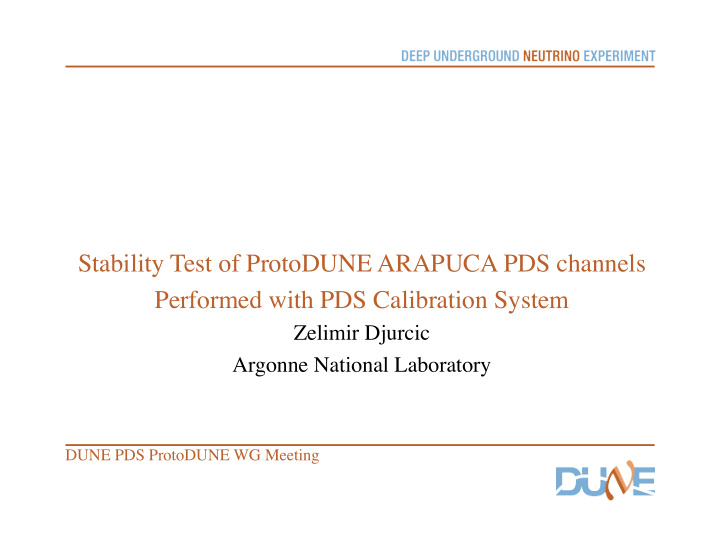



Stability Test of ProtoDUNE ARAPUCA PDS channels Performed with PDS Calibration System Zelimir Djurcic Argonne National Laboratory DUNE PDS ProtoDUNE WG Meeting
Stability Test Results • Recent “stability” analysis of PDS calibration data performed by Chris, Dante, Niccolo -See for example talks presented here https://indico.fnal.gov/event/20968/ • These stability results showed the following -the amount of detected light consistently went down on the beam drift side as a function of time (over past six months or so) -the amount of detected light stayed stable on the non-beam side • In the following slides we show an explanation for the observed effects 2
Stability Test Info • Used DCM Runs: -Jan/Feb: 6015 (double pulses), 6620 (single pulses), 6659 (single pulses) -Mar/Apr: 7363, 7445, 7473 (all single pulse runs) -June 25: 8507 -Pulse amplitude: UV LED bias = 30V -> “0x00040FFF” for all runs -Pulse width: 30 ns -> “0x9” for all runs • Integrate the waveform peak area for each channel Pedestal 1 Pedestal 2 Peak Integral 3
Stability Test Results • Make the following plot for each channel, fit the line and check the spread -example: ARAPUCA 1 channel 143 -example: ARAPUCA 2 channel 275 4
ARAPUCA 1 (ch 132-143) 5
ARAPUCA 2 (ch 262-275) 6
Single DCM Channel Run Results • ARAPUCA 1 (ch 132-143) 7
Single DCM Channel Run Results • ARAPUCA 1 (ch 132-143) Broken fiber (when installed) Arapuca 1 Fiber/diffuser moved from here to there (at CPA installation time) 8
Numerical Sum of Single DCM Channel Runs 9
Test of Numerical Sum of Single DCM Channel Runs -Sum of 4 single channel (ie single diffusers) DCM runs compared to two available “all” diffuser runs 10
Old data (red) vs New data (black) New data 11
Old data (red) vs New data (black) • Same as previous page 12
Matching Old data (red) vs New data (black) • Scale blue data-ONLY down by 22.5% (blue dots on previous slides = CENTRAL DIFFUSER only) => MAKING NEW DATA MATCHING THE OLD DATA ⇒ Provides a strong evidence that the “CENTER” calibration channel’s light yield has been decreasing 13
Summary • Recent “stability” analysis of PDS calibration data performed by Chris, Dante, Niccolo -See for example talks presented here https://indico.fnal.gov/event/20968/ • These stability results showed the following -the amount of detected light consistently went down on the beam drift (aka “rack”) side as a function of time (over past six months or so) -the amount of detected light stayed stable on the non-beam (aka “DAQ”) side • We provided a strong evidence that the “CENTER” calibration channel’s light yield has been decreasing, to explain the PDS collection stability (as decreasing) on tack side • These finding are suggesting that the DCM calibration runs are valuable tool to monitor the light yield stability but on rack side the analysis has to use individual calibration channels (aka “single diffusers”) other than the “CENTER” channel 14
Recommend
More recommend